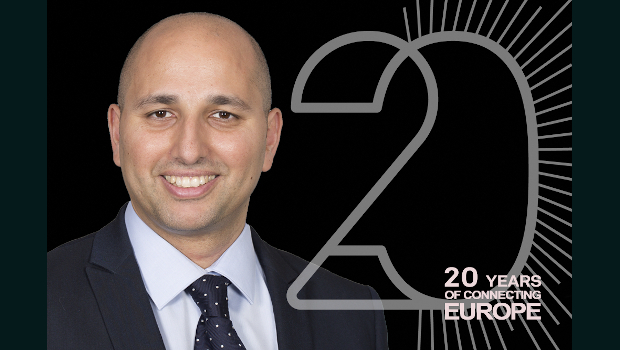
Mathematics as the cornerstone for innovation in ICT
In association with Huawei Technologies
Mathematics for fundamental breakthrough
We often hear by many colleagues that mathematics consists mainly in proving theorems. But is it a writer’s job mainly that of writing sentences?
Mathematics and its impact on the ICT industry in certainly more than that.
As a young student, I was told the following story and was quite amazed how effective the intrusion of the imaginary (and in extension of imagination) in mathematics can be to solve inextricable problems: A mathematician was crossing the desert on his camel, when he met three brothers, apparently very busy. Their father had just died and bequeathed them 17 camels, with very unusual testamentary dispositions.
You can judge by yourself: the elder was supposed to receive half, the second the third and the younger the ninth.
The neurons of the mathematician, invited to divide a prime number according to the prescribed ratio, rapidly found the solution: he generously added his camel to the 17 of the inheritance, so that the eldest could receive 9, the second 6 and the third 3 in accordance with the required distribution. Having solved the problem, the mathematician had only to conclude with these words: “And now, give me my camel back”.
This story provides the basic ingredients of mathematical research and in extension of creative research. In mathematical research, imagination is more important than knowledge. When a requested pre-defined problem is unsolvable, a mathematician will imagine a new problem. This is in sharp contrast with classical approaches that would stick to the initial boundaries. The new elegant solution will often not meet the initial constraints.
However, it will often provide a new point of view to the problem and a breakthrough solution for which there will be a consensus on the fact that we will need to change the initial constraints to move forward.
Of course, in many cases, the problem can be solved with the initial constraints but mathematicians will still strive to generalise the solution by providing the minimum required hypothesis.
Generalisation is key in mathematics. This is very important in engineering applications for what is called the ‘robustness’ of a solution or in extension of a product. The solution quality should not deviate much from optimality when small changes in the problem occur.
Fundamental breakthroughs in mathematics are also often based on the existence of solutions without necessarily providing the algorithmic construction of it. This sounds a bit like magic but is known as a non-constructive proof (also known as the pure existence theorem), which proves the existence of a particular kind of object without providing an example. This has led to important fundamental breakthroughs in the ICT field. The famous paper of Shannon from 1948 entitled A Mathematical Theory of Communication provides what is known as the ‘capacity’ of a channel but Shannon proved it without devising a practical coding scheme to achieve it.
Algorithms for practical breakthroughs
What is exactly an Algorithm? An algorithm in mathematics is a procedure, a description of a set of steps that can be used to solve a mathematical computation. It is like a cooking recipe.
It was Al-Khwarizmi’s who worked in Baghdad in the ninth century who gave rise to the term Algorithm.
Algorithms are ubiquitous and many of us are familiar with the Viterbi algorithm, the Fast Fourier Transform, the Branch and bound algorithm, the Expectation-Maximisation algorithm (EM Algorithm), the Dijkstra’s algorithm, the Gradient Descent, the Newton’s method or the LLL algorithm, just to name a few.
They have a huge impact in in the development of the telecommunication industry and some have become unavoidable.
The path from fundamental mathematics to mathematical algorithms and then engineering applications is a long path. The famous Fourier Transform is a typical example.
The idea of the Fourier transform is to decompose a function of time into its constituent frequencies. It is taught in all major electrical engineering courses as it gives a direct insight on the signal to process.
It was the French Mathematician Jean-Baptiste Joseph Fourier (1768-1830) who initiated the theory coming from application problems in heat transfer and vibration. It took many years to derive an algorithm to implement it.
Although there are some preliminary works of the German Mathematician Gauss on the fast Discrete Fourier Transform (DFT), it was not until 1965 that James Cooley and John Tukey published the famed Fast Fourier Transform Algorithm. The FFT became then the heart of all major technological innovations such as Wi-Fi, ADSL, LTE or DVB.
What is next?
Since 1948, many people are lacking landmark papers in our field for guidance. They feel a bit lost since Shannon.
Note that from a historical perspective, 1948 was a key year in the field of ICT as many other fundamental contributions appeared. The work of Wiener’s Cybernetics, or Control and Communication in the Animal and the Machine pioneered the field of Signal Processing with many applications related to detection, estimation and control for Communication Systems.
The book Theory of Games and Economic Behaviour of J. Von Neumann and O. Morgenstern opened the field of game theory and more generally learning agents Systems. All these contributions provided the key ingredients for many years of Algorithmic Research.
So what are we aiming for 2028? In fact, we have never been in a greater need of advanced mathematical tools than now and some new fundamental tools are already there to go beyond the actual limits (Shannon Limit and Nyquist Limit just to name these).
For a long time, we have tried to improve the same models because of the difficulty of dealing with new ones. But as it is commonly known, it is not because it is hard that we do not try but rather because we do not try that it is hard.
Dr Mérouane Debbah is director of the mathematical & algorithmic science laboratory at the Huawei Research Center in Paris







Subscribers 0
Fans 0
Followers 0
Followers